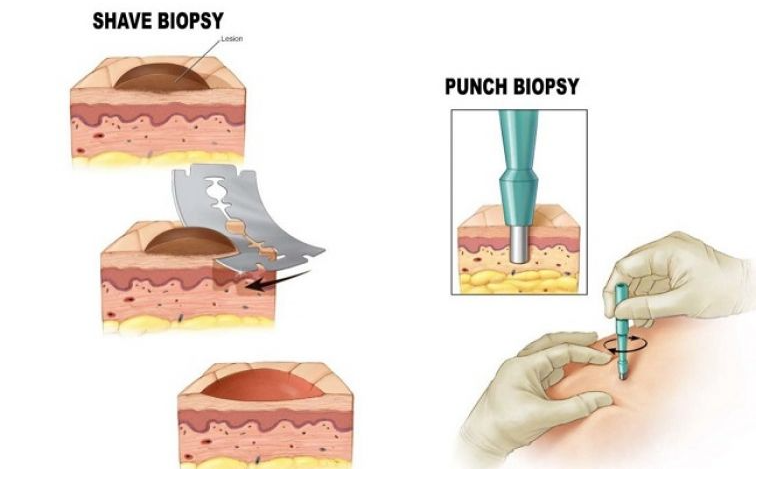Biopsy
What is a skin biopsy?
Skin biopsy is a procedure in which a small sample of skin is taken for testing. Skin samples are examined under a microscope for skin cancer, skin infections, or skin disorders such as psoriasis.
There are three main ways to have a skin biopsy:
Punch biopsy, which uses a special circular instrument to take a sample.
Correction biopsy, which removes the sample with a razor
Excisional biopsy, which removes a sample with a small knife called a scalpel.
The type of biopsy you have depends on the location and size of the abnormal area of skin known as the skin lesion. Most skin biopsies can be done in an office or other outpatient setting.
Other letters: Punch biopsy, Shave biopsy, Excisional biopsy, Skin cancer biopsy, Basal cell biopsy, Squamous cell biopsy, Melanoma biopsy

What is a biopsy used for?
Skin biopsy to help diagnose a variety of skin conditions including:
Skin disorders such as psoriasis and eczema
Bacterial or fungal infections of the skin
Skin Cancer. A biopsy can confirm or rule out suspected cancer of the mole or other skin lesions.
Skin cancer is the most common type of cancer in the United States. The most common types of skin cancer are basal cell and squamous cell carcinomas. These cancers rarely spread to other parts of the body and are usually treatable. The third type of skin cancer is called melanoma. Melanoma is less common than the other two, but it is more dangerous because it is more likely to spread. Most deaths from skin cancer are due to melanoma.
A skin biopsy can help diagnose skin cancer early, when it is easier to treat.
Why do I need a skin biopsy?
You may need a skin biopsy if you have certain skin symptoms, such as the following:
Persistent itching
Scaly or dry skin
Open wounds
A mole or growth of another lesion that varies in shape, color, and / or size
What happens during a skin biopsy?
The therapist first cleans the area and injects an anesthetic so that you do not feel any pain during the operation. The rest of the steps depend on the type of skin biopsy. There are three main types of biopsy:
Punch biopsy
The therapist places a special circular instrument on the abnormal area of skin (lesion) and rotates it to remove a small piece of skin.
The sample is removed with a special tool
If a larger skin sample is taken, you may need one or two stitches to cover the biopsy site.
It enters the pressure area until the bleeding stops.
The area is covered with a sterile bandage.
Puncture biopsies are often used to diagnose a rash.
Incision biopsy
The therapist uses a razor or scalpel to remove a sample from the top layer of your skin.
Pressure is applied to the biopsy site to stop the bleeding. You may also take a medicine that is placed on the skin (also called a topical medicine) to help stop the bleeding.
Incisional biopsies are often used if your therapist thinks you may have skin cancer or if the rash is limited to the top layer of your skin.
Excisional biopsy
The surgeon uses a scalpel to remove the entire skin lesion (abnormal area of skin).
The surgeon closes the biopsy site with sutures.
It enters the pressure area until the bleeding stops.
The area is covered with a sterile bandage.
Excisional biopsies are often used if your doctor thinks you may have melanoma, the most serious type of skin cancer.
After the biopsy, cover the affected area with a bandage until you have healed or until the stitches come out. If you have a suture, it will be removed 3 to 14 days after the operation.
Do I have to do anything to prepare for the biopsy?
You do not need special preparation for skin biopsy.
Is there a risk for testing?
You may have some bruising, bleeding, or pain at the biopsy site. If these symptoms last for more than a few days or get worse, talk to your doctor.
What do these results mean?
If your results are normal, it means that no cancer or skin disease has been found. If your results are not normal, one of the following conditions may be diagnosed:
Bacterial or fungal infection
A skin disorder such as psoriasis
Skin Cancer. Your results may indicate one of three types of skin cancer: basal cell carcinoma, squamous cell carcinoma, or melanoma.
Learn more about lab tests, reference range, and understanding of results.
Do I need to know anything else about skin biopsies?
If you are diagnosed with basal cell carcinoma or squamous cell carcinoma, the entire cancerous lesion may be removed at or immediately after the skin biopsy. Often, no further treatment is needed. If you are diagnosed with melanoma, you need more tests to see if the cancer has spread. Your doctor can then create the right treatment plan for you.